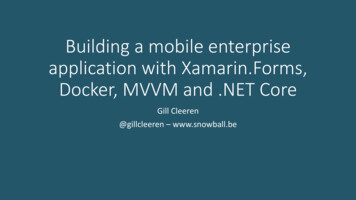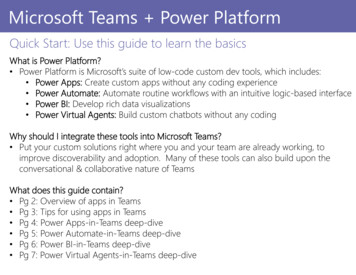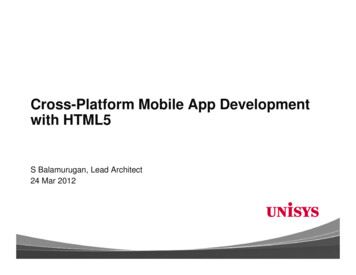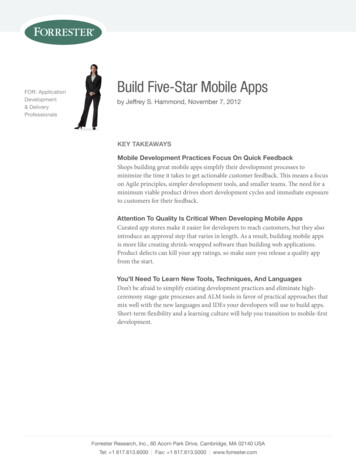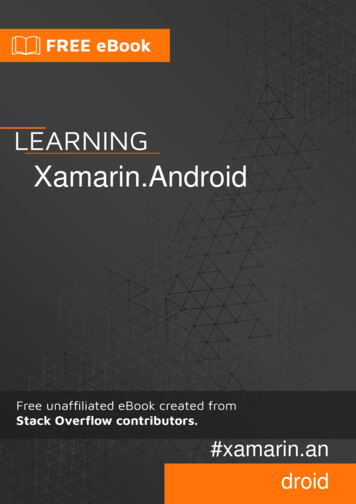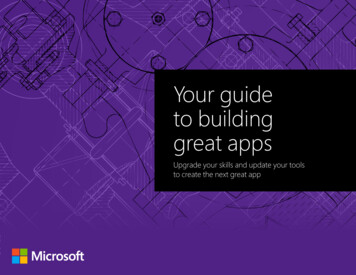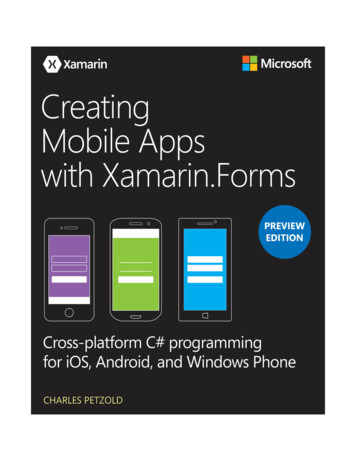
Transcription
PREVIEW EDITIONThis excerpt provides early content from a book currently in developmentand is still in draft format. See additional notice below.PUBLISHED BYMicrosoft PressA Division of Microsoft CorporationOne Microsoft WayRedmond, Washington 98052-6399Copyright 2014 Xamarin, Inc.All rights reserved. No part of the contents of this book may be reproduced or transmitted in any form or by any meanswithout the written permission of the publisher.ISBN: 978-0-7356-9725-6Microsoft Press books are available through booksellers and distributors worldwide. Please tell us what you think of thisbook at http://aka.ms/tellpress.This document is provided for informational purposes only and Microsoft makes no warranties, either express or implied,in this document. Information in this document, including URL and other Internet website references, is subject to changewithout notice. The entire risk of the use or the results from the use of this document remains with the user.This ERRN H[SUHVVHV WKH DXWKRU·s views and opinions. The information contained in this book is provided without anyexpress, statutory, or implied warranties. Neither the authors, Microsoft Corporation, nor its resellers, or distributors will beheld liable for any damages caused or alleged to be caused either directly or indirectly by this book.Complying with all applicable copyright laws is the responsibility of the user. Without limiting the rights undercopyright, no part of this document may be reproduced, stored in or introduced into a retrieval system, or transmittedin any form or by any means (electronic, mechanical, photocopying, recording, or otherwise), or for any purpose,without the express written permission of Microsoft Corporation.Microsoft and the trademarks listed at ctualProperty/ Trademarks/ENUS.aspx are trademarks of the Microsoft group of companies. All other marks are property of their respective owners.The example companies, organizations, products, domain names, email addresses, logos, people, places, and eventsdepicted herein are fictitious. No association with any real company, organization, product, domain name, email address,logo, person, place, or event is intended or should be inferred.This ERRN H[SUHVVHV WKH DXWKRU·s views and opinions. The information contained in this book is provided without anyexpress, statutory, or implied warranties. Neither the authors, Microsoft Corporation, nor its resellers, or distributors will beheld liable for any damages caused or alleged to be caused either directly or indirectly by this book.Acquisitions and Project Editor: Devon MusgraveCover illustration: Serena Zhang
Table of contentsIntroduction . 7Who should read this book . 7Assumptions . 7Organization of this book . 7Conventions and features in this book. 8System requirements . 8Downloads: Code samples . 9Updating the code samples . 9Acknowledgments .10Free ebooks from Microsoft Press .10We want to hear from you .10Chapter 1How does Xamarin.Forms fit in?. 11Cross-platform mobile development .12The mobile landscape .12Problem 1: Different user-interface paradigms .12Problem 2: Different development environments .13Problem 3: Different programming interfaces .13Problem 4: Different programming languages .13The C# and .NET solution .14A single language for all platforms .15Sharing code .16Introducing Xamarin.Forms .18The Xamarin.Forms option .18XAML support .20Platform specificity .222
A cross-platform panacea? . 23Your development environment. 23Machines and IDEs . 24Devices and emulators. 24Installation. 25Creating an iOS app. 25Creating an Android app . 26Creating a Windows Phone app . 26All ready?. 26Chapter 2Pages, layouts, and views . 27Say hello . 28Anatomy of a Xamarin.Forms solution . 30The iOS project . 32The Android project. 33The Windows Phone project . 34Nothing special! . 34PCL or SAP? . 35Labels for text . 371. Include padding on the page . 402. Include padding just for iOS . 413. Center the label within the page . 424. Center the text within the label . 44Wrapping paragraphs . 45Text and background colors . 47The Color structure . 49Standard fonts and sizes . 52Formatted text . 543
Stacks of views .57Scrolling content .60The layout expand option .65Frame and BoxView .69A ScrollView in a StackLayout? .74The button for commands .78Sharing button clicks .81Anonymous event handlers .83Distinguishing views with IDs .85Chapter 3Building an app: Infrastructure . 89Version 1. The Entry and Editor views .91Version 2. File input/output.95Skip past the scary stuff? .97Preprocessing in the SAP .97Dependency service in the PCL . 102Version 3. Going async. 106Asynchronous lambdas in the SAP. 109Method callbacks in the PCL . 114Version 4. I will notify you when the property changes . 119Version 5. Data binding . 126Streamlining INotifyPropertyChanged classes . 127A peek into BindableObject and bindable properties . 130Automated data bindings . 133Version 6. Awaiting results . 137:KDW·V QH[W". 150Chapter 4Building an app: Architecture .151Version 7. Page navigation. 151Version 8. Notes in the ListView . 1574
Enumerating files .159The ListView .162Version 9. Editing and deleting .169Version 10. Adding a template cell .175Version 11. Constructing a toolbar .178Icons for Android .179Icons for Windows Phone.180Icons for iOS devices.180ToolbarItem code .181Version 12. Application lifecycle events .185The iOS implementation .188The Android implementation .188The Windows Phone implementation .190Saving and restoring .191Making it pretty.195Chapter 5Principles of presentation .197The Xamarin.Forms class hierarchy .197Pixels, points, dps, DIPs, and DIUs .203Estimated font sizes .2083URJUDPPHU·V ILUVW clock app .213Image and bitmaps .215Absolute layout and attached bindable properties .221AbsoluteLayout proportionally .229Chapter 6The interactive interface .233View overview .233Slider, Stepper, and Switch .234Data binding.238Date and time selection .2455
Custom views: A radio button . 248Mastering the Grid . 257The Grid and attached bindable properties . 2626
IntroductionThis is a Preview Edition of a book about writing applications for Xamarin.Forms, the exciting newmobile development platform for iOS, Android, and Windows Phone unveiled by Xamarin in May 2014.Xamarin.Forms lets you write shared user-interface code in C# and XAML (the eXtensible ApplicationMarkup Language) that maps to native controls on these three platforms.This book is a Preview Edition because it's not complete. It has only six chapters. We anticipate thatthe final version of the book will have at least half a dozen additional chapters and that the chapters inthis Preview Edition might be fleshed out, enhanced, or completely reconceived. The final edition ofthe book will probably be published in the spring of 2015.Who should read this bookThis book is for C# programmers who want to write applications for the three most popular mobileplatforms: iOS, Android, and Windows Phone with a single code base. Xamarin.Forms also hasapplicability for those programmers who want eventually to use C# and the Xamarin.iOS andXamarin.Android libraries to target the native application programming interfaces (APIs) of theseplatforms. Xamarin.Forms can be a big help in getting started with these platforms or in constructing aprototype or proof-of-concept application.AssumptionsThis book assumes that you know C# and have some familiarity with the use of the .NET Framework.However, when I discuss some C# and .NET features that might be somewhat new to recent C#programmers, I adopt a somewhat slower pace. In particular, the introduction of the async keywordand await operator in Chapter 3 follows a discussion that shows how to do asynchronousprogramming using traditional callback methods.Organization of this bookThis book is intended as a tutorial to learn Xamarin.Forms programming. It is not a replacement for theonline API documentation, which can be found here under the heading Xamarin.Forms Framework onthis page: http://api.xamarin.com/.This Preview Edition's Chapter 1 discusses Xamarin.Forms in the larger context of mobile developmentand the Xamarin platform and also covers the hardware and software configurations you'll need.Chapter 2 explores some of the basics of Xamarin.Forms programming, including the use of Label,Button, and StackLayout.7
In Chapters 3 and 4, however, I tried to do something a little different: These chapters show theprogressive step-by-step development of a small Xamarin.Forms application. Despite the simplicity ofthis program, it is in many ways a "real" application, and requires essential real-app facilities such as fileI/O and application lifecycle handling, both of which turned out to be somewhat more challengingthan I originally anticipated. I'm curious to hear whether these two chapters "work" or not. See thesection below on submitting feedback to us.Chapters 5 and 6 return to more conventional API tutorials. My biggest regret is that I wasn't able toget some coverage of XAML into this Preview Edition. However, the Xamarin website has someadditional resources for learning Xamarin.Forms including a six-part "XAML for Xamarin.Forms"document: /xamarin-forms/.Conventions and features in this bookThis book has just a few typographical conventions:xAll programming elements referenced in the text³including classes, methods, properties,variable names, etc.³are shown in a monospaced font, such as the StackLayout class.xItems that appear in the user interface of Visual Studio or Xamarin Studio, or the applicationsdiscussed in these chapters, appear in boldface, such as the Add New Project dialog.xApplication solutions and projects also appear in boldface, such as ColorScroll.System requirementsThis book assumes that you'll be using Xamarin.Forms to write applications that simultaneously targetall three supported mobile platforms³iOS, Android, and Windows Phone. However, it's very likely thatmany readers will be targeting only one or two platforms in their Xamarin.Forms solutions. Theplatforms you target³and the Xamarin Platform package you purchase³govern your hardware andsoftware requirements. For targeting iOS devices, you'll need a Mac installed with Apple XCode as wellas the Xamarin Platform, which includes Xamarin Studio. For targeting Windows Phone, you'll needVisual Studio 2012 or 2013 (not an Express Edition) on a PC, and you'll need to have installed theXamarin Platform.However, you can also use Visual Studio on the PC to target iOS devices if the Mac with XCode andthe Xamarin Platform is accessible via WiFi. You can target Android devices from Visual Studio on thePC or from Xamarin Studio on either the PC or Mac.Chapter 1 has more details on the various configurations you can use, and resources for additionalinformation and support. My setup for creating this book consisted of a Microsoft Surface Pro 2 (withexternal monitor, keyboard and mouse) installed with Visual Studio 2013 and the Xamarin Platform,8
connected by WiFi with a MacBook Pro installed with XCode and the Xamarin Platform.Downloads: Code samplesThe sample programs shown in the pages of this book were compiled in early September with version1.2.2.6243 of Xamarin.Forms. The source code of these samples is hosted on a repository on ok-preview/.You can clone the directory structure to a local drive on your machine, or download a big ZIP file. I'lltry to keep the code updated with the latest release of Xamarin.Forms and to fix (and comment) anyerrors that might have sneaked through.You can report problems, bugs, or other kinds of feedback about the book or source code byclicking the Issues button on this GitHub page. You can search through existing issues or file a newone. To file a new issue, you'll need to join GitHub (if you haven't already).Use this GibHub page only for issues involving the book. For questions or discussions aboutXamarin.Forms itself, use the Xamarin.Forms forum: Updating the code samplesThe libraries that comprise Xamarin.Forms are distributed via the NuGet package manager. TheXamarin.Forms package consists of five dynamic-link libraries: Xamarin.Forms.Core.dll,Xamarin.Forms.Xaml.dll, Xamarin.Forms.Platform.iOS.dll, Xamarin.Forms.Platform.Android.dll, andXamarin.Forms.Platform.WP8.dll. The Xamarin.Forms package also requires Xamarin Support Library v4(Xamarin.Android.Support.v4.dll) and the Windows Phone Toolkit (Microsoft.Phone.Controls.Toolkit.dll), which should be automatically included.When you create a new Xamarin.Forms solution using Visual Studio or Xamarin Studio, a version ofthe Xamarin.Forms package becomes part of that solution. However, that might not be the latestXamarin.Forms package available from NuGet. Here's how to update that package:In Visual Studio, right-click the solution name in the Solution Explorer and select Manage NuGetPackages for Solution. Select Installed packages at the left of the dialog to see what's currentlyinstalled, and Updates and nuget.org at the left to choose to update the package. If an update isavailable, clicking the Update All button is easiest to get it into the solution.In Xamarin Studio, in the individual projects in the Solution list, under Packages, select theXamarin.Forms package and select Update from the tool dropdown.The source code for this book that is stored on GitHub does not include the actual NuGet packages.Xamarin Studio will automatically download them when you load the solution, but Visual Studio willnot. After you first load the solution into Visual Studio, right-click the solution name in the Solution9
Explorer and select Manage NuGet Packages for Solution. You should be given the option torestore the packages with a Restore button at the top of the dialog. You can then update the packageby selecting Updates and nuget.org at the left and (if an update exists) pressing the Update Allbutton.AcknowledgmentsIt's always seemed peculiar to me that authors of programming books (
Chapters 5 and 6 return to more conventional API tutorials. My biggest regret is that I wasn't able to get some coverage of XAML into this Preview Edition. However, the Xamarin website has some additional resources for learning Xamarin.Forms inclu
